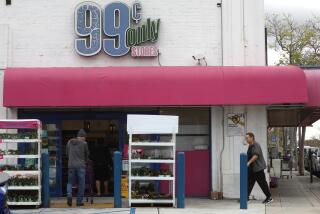‘Echo Boom’ Spurs Baby-Store Mania
- Share via
It seemed like an obvious relationship: More babies were being born, so retailers opened more baby stores.
Retailers were slow, at first, to spot the trend. But in the last several years, the rush to cash in on baby-mania has been evident at malls and shopping centers across the nation:
* Baby-oriented retailers Baby Superstore and Gymboree Corp., both flush with cash after public stock offerings in late 1994, have been on aggressive expansion campaigns.
* Gap Inc. has put expanded BabyGap departments in all its GapKids stores and begun building free-standing baby stores.
* Since late 1994, Limited Inc. has added baby goods to 185 of its 303 Limited Too stores for kids and is still going.
* Burlington Coat Factory has Baby Depot departments in about 150 of 220 stores and opened its first free-standing baby store last year on Long Island.
Driving this retailing binge is what demographers call the “echo boom”--the big generation born to baby boomers.
But some retail executives and analysts warn that the explosion of new retail stores might be coming as the echo is fading.
The number of babies born in this country slowly rose throughout the late 1980s, and in 1989 hit 4 million for the first time since 1964. But since 1990, the number has slowly fallen, to 3.94 million last year, and the Commerce Department predicts the rate will continue to fall for at least the next eight years. That’s particularly important for the baby business, experts point out, because babies remain baby-store customers three years or less. So a birth rate decline quickly affects the customer base.
“Anyone who is trying to develop [a] share of [the] market at this point is going to have their lunch eaten,” said retail analyst Alan Millstein in New York.
Yet retailers continue to jump on the baby bandwagon. Industry powerhouse Toys R Us Inc. launched an aggressive expansion with its first Babies R Us superstore. It plans to open eight more this year and 30 to 50 next year.
Industry experts say that even when births level off at about 3.5 million a year, probably in about 2005, baby retailing will be a multibillion-dollar industry. Analysts cite older mothers and two-income couples spending more money on their babies and the desire of retailers to develop brand awareness, or even customers for life. The business has also just begun to be transformed by the superstore formats that are so successful in retail generally.
Warren Hashagen, chief financial officer for Gap, cites these reasons when he says that “there are still some opportunities out there” for baby-oriented stores.
But he added: “I certainly think that not everyone who decides to get in is still going to be in the market and making money five years from now. There’s only so much market for people to share.”
Gap, widely credited as the first national specialty chain to recognize the potential of the baby business, opened its first BabyGap department in 1990, the peak of the echo boom.
Clark Hinkley, executive vice president of conservative women’s apparel chain Talbots Inc., said the chain began stocking baby clothes in its kids stores last fall because customers were asking for them.
Louis Lipschitz, chief financial officer of Toys R Us, said it launched its baby business last month because other retailers had shown there was a market opportunity. “As we see other people getting into it, we say, ‘Hey, wait a minute--we’re in this business, we can give it to them because we have the expertise,’ ” he said.
More to Read
Inside the business of entertainment
The Wide Shot brings you news, analysis and insights on everything from streaming wars to production — and what it all means for the future.
You may occasionally receive promotional content from the Los Angeles Times.









